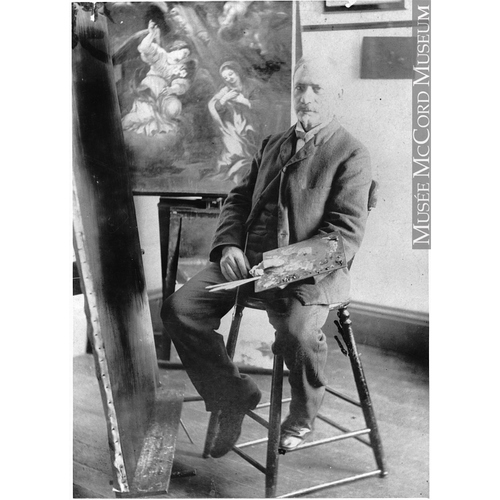
William Raphael (1833-1914) was a Canadian painter whose vibrant and detailed depictions of Montreal life in the 19th century have left an indelible mark on Canadian art history. Born in Prussia, Germany, Raphael's artistic journey began at the prestigious Royal Academy of Berlin, where he studied under notable artists such as Wolf and Begas. His early training laid the foundation for a career that would span continents and genres, but it was in Montreal where Raphael truly found his artistic voice.
Early Life and Education
Raphael was born into a German-Jewish family in 1833, and his early exposure to art came from his studies at the Royal Academy of Berlin around 1853-54. The academy was a center for academic art, and Raphael would have been influenced by the precision and attention to detail that characterized the works of his instructors. Among these influences was the Biedermeier artist Eduard Gartner, known for his meticulous depictions of urban scenes. This attention to architectural detail and the everyday lives of people would later become a hallmark of Raphael’s own work.
In 1856, Raphael emigrated to New York City, where he initially made a living as a portrait artist. However, just a year later, he moved to Montreal, a city that would become his home and the primary subject of his art for the rest of his life.
The Montreal Years: Genre Painting and Urban Life
Upon settling in Montreal in 1857, Raphael continued his work as a portrait artist. By the 1870s, his focus began to shift towards genre painting, a style that depicted scenes of everyday life. This transition may have been influenced by his exposure to the Biedermeier tradition during his time in Berlin. The Biedermeier artists, who often portrayed the lives of peasants and the beauty of nature, found a kindred spirit in Raphael, who began to document the bustling life of Montreal's streets and markets.
One of Raphael's most iconic works is Behind Bonsecours Market, Montreal (previously titled Immigrants at Montreal), a vivid and bustling scene of the city's Bonsecours Market area. The painting is rich in color and detail, capturing the architecture, the golden sunlight, and the diverse array of people who populated the market. It is suspected that Raphael included a self-portrait in this painting, depicting himself as a man carrying an artist’s portfolio and a Jewish ceremonial candelabra—a nod to his heritage and his profession.
Raphael's works offer a unique window into the past, providing a detailed record of Montreal’s urban landscape in the late 19th century. His paintings are more than just artistic creations; they are historical documents that give us a glimpse into the daily lives of the city's inhabitants over a century ago. Whether it was the lively market scenes, the serene urban landscapes, or the various people he depicted, Raphael’s art brings 19th-century Montreal to life in a way that few others have managed.
A Versatile Artist
While Raphael is best known for his Montreal scenes, his artistic range was broad. He painted Indian encampments, settlers in the rugged Canadian wilderness, and dramatic scenes like travelers menaced by wolves. His work also included landscapes, floral subjects, animal portraits, and character studies, showcasing his versatility as an artist. Despite his wide-ranging subject matter, Raphael’s heart always remained in Quebec, where he found endless inspiration for his art.
In addition to his painting, Raphael was active as an illustrator, contributing drawings to the book Picturesque Canada. His painting The Early Bird Catches the Worm was reproduced in 1874 as the first chromolithograph in Canada, further cementing his place in Canadian art history.

Contributions to Art and Education
William Raphael was not just a painter; he was also a dedicated educator and a key figure in the Montreal art scene. He was a charter member of the Royal Canadian Academy of Arts in 1880 and a member of the Society of Canadian Artists in Montreal (1887). Raphael also played a significant role in art education in Montreal. He conducted drawing and painting classes and was the first to introduce drawing from life and from the cast in the city. In 1880, he taught figure painting and drawing for the first classes of the Art Association of Montreal, helping to lay the groundwork for future generations of Canadian artists.
Legacy
William Raphael's work is represented in numerous prestigious collections, including the Beaverbrook Art Gallery in Fredericton, the McCord Museum at McGill University in Montreal, the Montreal Museum of Fine Arts, and the National Gallery of Canada in Ottawa. His legacy as a painter who captured the spirit of Montreal in the 19th century endures, offering a rich visual history of a bygone era.
Raphael’s son, Samuel Raphael, followed in his father’s footsteps and became an artist working in the New York area, ensuring that the Raphael artistic legacy would continue.
William Raphael passed away in Montreal in 1914 at the age of 81. His works remain a vibrant and invaluable record of Canadian life, offering future generations a window into the past through the eyes of a masterful painter.
Browse our collection of Canadian paintings for sale at the Canadian Classic Fine Art gallery, The best place to buy a painting online. We provide free shipping anywhere in Canada and the United States. Our Montreal art gallery sells paintings online exclusively and have a 14 days return policy.
